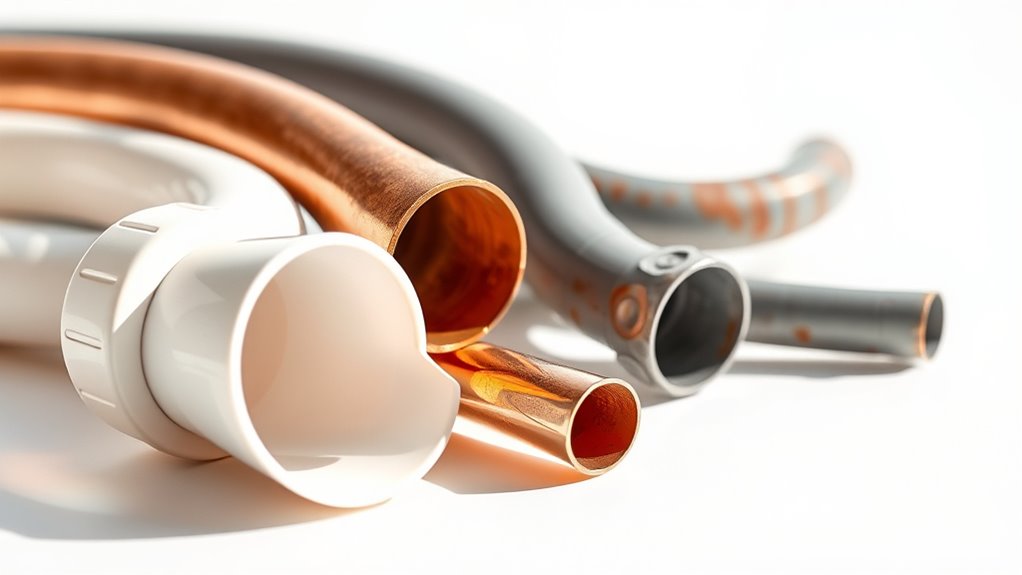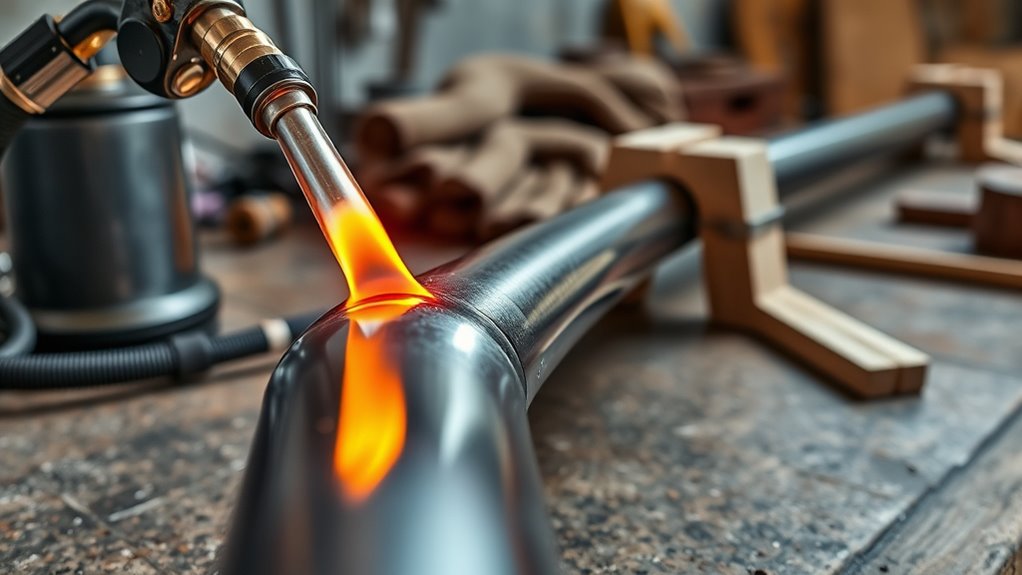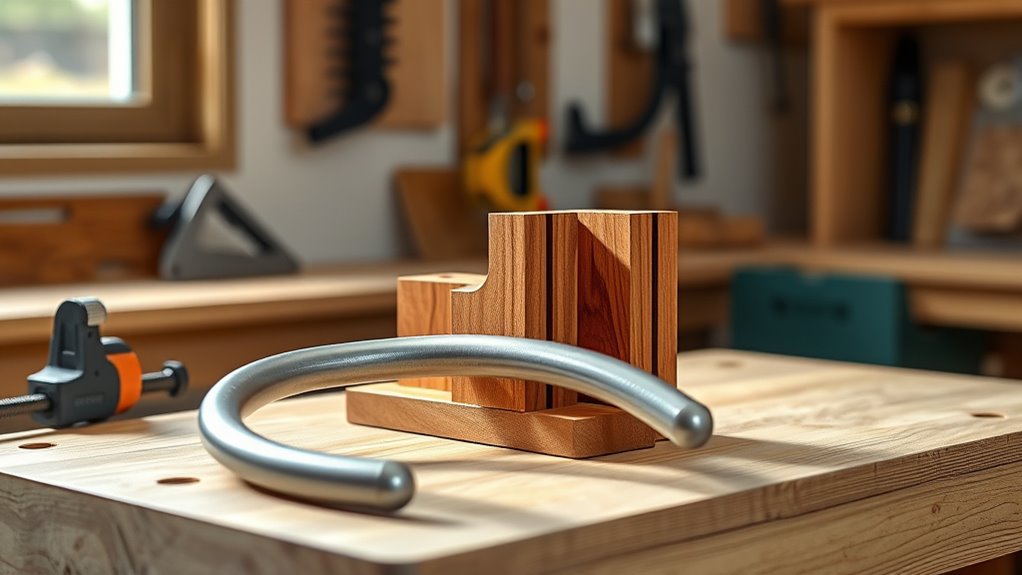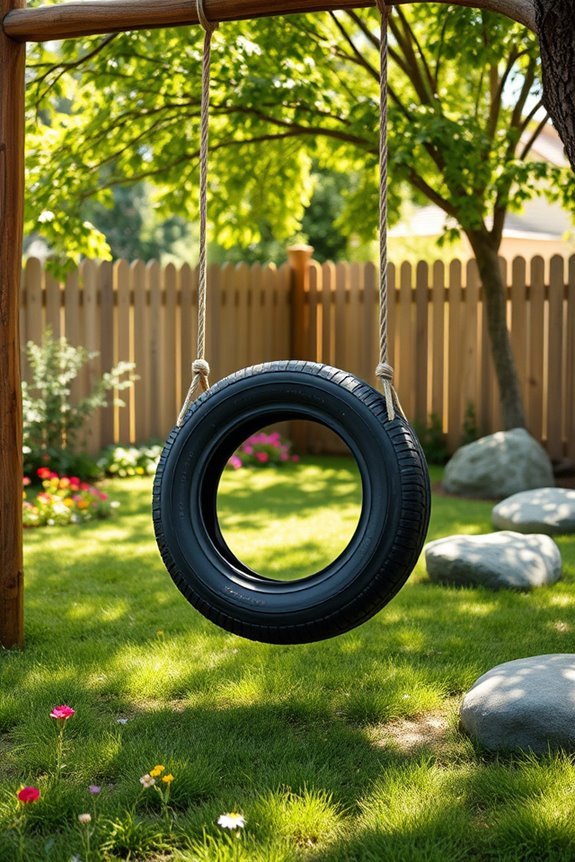How to Bend Pipe Without a Pipe Bender: Simple DIY Methods and Tools
Bending pipe without a pipe bender can be achieved through a few effective DIY methods. Here are three simple techniques:
- Heat Method: Use a heat source like a propane torch to gently heat the section of the pipe you want to bend. Be cautious to avoid overheating, which can damage the material.
- Filling for Support: Fill the pipe with sand or water to prevent it from collapsing while bending. Once the bend is complete, you can remove the filler.
- Car Jack Technique: Position the pipe in a sturdy location and use a car jack to apply even pressure. This method allows for a controlled bend without risking damage.
Always measure accurately before starting, and ensure you follow safety precautions to prevent injuries. Avoid common mistakes like bending too quickly or not supporting the pipe properly. With these methods, you can successfully bend pipe without specialized equipment.
Understanding Pipe Materials and Their Flexibility

Understanding the flexibility of different pipe materials is crucial for effective bending without specialized tools.
Here’s a quick guide to help you choose the right material for your project:
- Copper: Highly malleable, copper pipes can be easily shaped by hand, making them ideal for intricate bends.
- PVC: Offers some flexibility but can crack if bent too sharply. Best for gentle curves.
- Steel: Generally rigid, but can be bent with the right techniques and tools, requiring more force.
- Aluminum: Strikes a balance between strength and flexibility, suitable for various applications.
Select the appropriate material based on these properties to achieve safe and successful bending results.
The Importance of Proper Measurements
Proper measurements are crucial for bending pipe accurately. To achieve precise bends in length and angle, it’s important to use the right techniques for calculating angles. This ensures the desired bend is made while maintaining the material’s integrity.
Additionally, the thickness of the material plays a significant role in the bending process and affects the final result. By focusing on these factors, you can achieve optimal bending outcomes.
Accurate Length Measurements
Accurate length measurements are crucial for successful pipe bending. Even small discrepancies can lead to significant fit and function issues.
To ensure correct alignment with other components and avoid gaps or overlaps, use a reliable measuring tool like a tape measure or caliper. Mark the pipe clearly and measure multiple times for confirmation.
Keep in mind that the material and thickness of the pipe can influence its behavior during bending. Prioritizing precise length measurements is essential for achieving optimal results in your pipe bending project.
Angle Calculation Techniques
To ensure flawless execution of pipe bend angles, precise angle calculation is crucial. Here are key steps to achieve accurate bends:
- Measure Carefully: Use tools like protractors or digital angle finders to determine the exact angle needed for your project.
- Consider Bend Radius: Factor in the radius of the bend and the material type, as these can affect the outcome.
- Mark the Pipe: Clearly mark lines on the pipe before bending to maintain consistency throughout the process.
Material Thickness Considerations
When bending pipes, understanding material thickness is crucial. Thicker materials resist deformation, making them harder to bend and increasing the risk of cracking or kinking.
On the other hand, thinner materials are easier to bend but may lose structural integrity if bent too sharply.
Therefore, measuring the material’s thickness accurately is vital for choosing the right bending technique. This ensures that your final product has the desired shape and strength, enabling successful DIY projects without specialized tools.
Using Heat to Bend Pipes

When bending pipes with heat, you can use tools like propane torches or heat guns.
Always prioritize safety by wearing protective gear and working in a well-ventilated area.
Understanding how to use these tools effectively will help you achieve a precise bend while maintaining the pipe’s integrity.
Heat Sources Options
Bending pipe can be made easier with the right heat source. Here are some effective options to consider:
| Heat Source | Description |
|---|---|
| Propane Torch | Portable and effective for bending metal pipes. |
| Heat Gun | Best suited for bending plastic pipes. |
| Stovetop | Great for heating small diameter pipes. |
| Oven | Provides even heating for materials. |
Choosing the appropriate heat source is crucial for achieving the desired bend while ensuring the pipe maintains its integrity.
Safety Precautions Needed
When using heat sources like propane torches or heat guns to bend pipe, safety is paramount. Here are key precautions to follow:
- Wear Protective Gear: Always equip yourself with heat-resistant gloves, safety goggles, and long sleeves to protect against burns and flying debris.
- Ensure Ventilation: Work in a well-ventilated area to avoid inhaling harmful fumes.
- Clear Flammable Materials: Keep flammable items away from the heat source and declutter the workspace to reduce fire risk.
- Use a Heat-Resistant Surface: Work on a surface that can withstand high temperatures to protect the underlying area.
- Monitor Pipe Temperature: Regularly check the pipe for overheating to ensure proper bending without damaging its structure.
Water-Filled Pipe Method
The water-filled pipe method is an effective and straightforward way to bend pipes without needing specialized tools. This technique prevents pipe collapse during bending by using water.
Here’s how to do it:
- Seal one end of the pipe: Use a cap or tape to prevent water from escaping.
- Fill the pipe with water: Completely fill the pipe with water, minimizing air pockets.
- Seal the other end: Securely cap or tape the open end to maintain pressure.
- Heat the pipe: Evenly apply heat to the section of the pipe you want to bend.
This method allows for controlled bending, ensuring the pipe remains undamaged.
Sand Filling Technique
The sand filling technique is an effective method for bending pipes without specialized tools.
To use this technique, first seal one end of the pipe with a cap or duct tape. Fill the pipe with dry sand, ensuring there are no air pockets, and then seal the open end.
This preparation allows you to bend the pipe gradually using manual force or a vice while the sand provides internal support, preventing collapse.
Once the desired bend is achieved, simply remove the seals and empty the sand.
This economical method works well for various materials, including metal and PVC.
Leveraging a Wooden Jig

If you’re looking for a practical method to bend pipes without a pipe bender, creating a wooden jig can be an effective solution. Here’s how to make one:
- Gather Materials: Use sturdy wood, screws, and clamps for a solid base.
- Design the Jig: Mark the desired bend angle and shape on the wood, ensuring it fits the pipe’s diameter.
- Build the Jig: Cut and assemble the wood to create a channel for the pipe.
- Test Your Jig: Place the pipe in the jig and apply gradual pressure to achieve the bend, making adjustments as needed.
This technique allows for precise bending while protecting the integrity of the pipe.
Using a Vice for Manual Bending
When manually bending pipe using a vice, proper preparation is crucial for accurate results. To ensure the pipe maintains its integrity during the bending process, follow these essential steps:
- Select the Right Pipe: Choose a pipe that is suitable for bending, considering its material and thickness.
- Measure and Mark: Measure the desired angle and mark the pipe clearly to ensure precision.
- Secure the Pipe: Place the pipe in the vice, ensuring it is held firmly but not overly tight to avoid deformation.
- Bend Gradually: Apply steady pressure while bending, taking care to maintain control. Bend slowly to avoid kinks or breaks.
- Check Alignment: After bending, check the angle and alignment against your markings for accuracy.
Preparing the Pipe
How to Prepare a Pipe for Manual Bending
Preparing a pipe correctly is crucial for achieving a smooth bend without kinks. Here’s a concise guide to ensure success:
- Choose the Right Pipe: Select a suitable material and diameter for bending.
- Clean the Pipe: Eliminate rust, paint, and debris for a smooth bending surface.
- Mark the Bend Area: Clearly indicate the bending point for precise alignment.
- Secure in a Vice: Firmly clamp the pipe to prevent movement during bending.
Bending Technique Steps
To bend a pipe effectively, follow these steps:
- Secure the pipe in a vice to ensure stability.
- Measure and mark the exact location for the bend.
- Apply steady pressure using your hands or a lever to achieve the desired angle, maintaining consistent force to avoid kinks or cracks.
- For larger bends, use a wooden block underneath the pipe for added support and to distribute pressure evenly.
- Once the bend is complete, release the pipe from the vice and inspect it for uniformity.
Make any necessary adjustments to ensure it meets your project specifications.
These concise steps will help you achieve a clean and accurate pipe bend.
Employing a Hammer and Anvil
Bending pipe using a hammer and anvil is a practical solution for small projects or when specialized tools aren’t available.
Here’s how to do it effectively:
- Choose Your Pipe: Select the appropriate type and diameter.
- Set Up on Anvil: Securely position the pipe on the anvil, aligning it for the bend.
- Hammer Technique: Gently strike the pipe with a hammer, gradually achieving the desired angle.
- Monitor Progress: Regularly check the angle and straightness to ensure precision.
This method allows for precise bending without damaging the pipe.
The Role of a Pipe Wrap
A pipe wrap is an essential tool for bending pipes without damaging them. Made from durable materials like rubber or foam, it cushions the pipe, preventing kinks and fractures.
By wrapping it around the section to be bent, users can evenly distribute pressure, resulting in smooth curves. This is particularly beneficial for softer metals or thin-walled pipes.
Additionally, a pipe wrap helps maintain the desired angle during the bending process. Using a pipe wrap ensures a high-quality bend, meeting your specifications without compromising the pipe’s integrity.
Bending With a Strap or Chain
Bending pipe using a strap or chain is a straightforward and effective method for DIY projects. Here’s how to do it safely and efficiently:
- Choose a Strong Strap or Chain: Ensure it can support the diameter and material of your pipe.
- Wrap Around the Pipe: Place the strap or chain at the point where you want the bend, making sure it’s snug.
- Secure the Ends: Attach the strap or chain to a fixed point to create leverage.
- Apply Gradual Force: Slowly bend the pipe, checking frequently to avoid over-bending or kinking.
This technique is accessible and ideal for various projects, fulfilling the need for effective pipe bending without specialized tools.
Creating a Simple Bending Form
Creating a bending form is essential for achieving precise and high-quality pipe bends in your DIY projects. To make one, follow these steps:
- Measure Your Pipe: Determine the length of the pipe and the desired bend radius.
- Create a Template: Draw or trace the curve onto a sturdy material like wood or metal, ensuring accuracy in dimensions.
- Cut Out the Form: Carefully cut along the template to create your bending form.
- Test the Form: Use a scrap piece of pipe to check the curvature and ensure it meets your needs.
Using a bending form helps you achieve consistent bends and minimizes the risk of kinks or imperfections, leading to better results in your projects.
Using a Car Jack for Pipe Bending
Using a car jack for bending pipe is a practical solution if you don’t have a pipe bender. To get started, you’ll need a few essential materials, including the pipe you want to bend, a sturdy base for the jack, and a bending form or template.
Follow these simple steps:
- Set Up: Secure the pipe on a stable surface and position the bending form around it.
- Position the Jack: Place the car jack at one end of the pipe, ensuring it’s aligned with the bending form.
- Apply Pressure: Slowly raise the jack to apply pressure on the pipe. Monitor the bend closely to achieve the desired angle.
- Release and Check: Once the bend is made, carefully lower the jack and check the angle. Repeat if necessary for adjustments.
This method allows for accurate bends without needing specialized equipment, making it a handy option for DIY projects.
Materials Needed for Bending
To bend pipe effectively using a car jack, you’ll need a few essential materials:
- Car Jack: A hydraulic or bottle jack is crucial for generating the force needed to bend the pipe.
- Pipe: Choose the right diameter and material based on your project requirements.
- Supports: Sturdy blocks or stands are necessary to stabilize the pipe during bending.
- Protective Gear: Always wear safety glasses and gloves to protect yourself while working.
Having these materials ready will help you achieve a safe and efficient pipe bending process.
Step-by-Step Bending Process
To bend a pipe effectively without specialized tools, follow these steps:
- Position the Pipe: Place the pipe on a stable surface, ensuring both ends are adequately supported.
- Set Up the Car Jack: Position the car jack beneath the center of the pipe, aligning it perpendicular to the area where you want to create the bend.
- Pump the Jack: Gradually pump the jack, applying even pressure to form a smooth curve. Check the bend angle periodically to ensure it meets your requirements.
- Release the Jack: Once the desired bend is achieved, slowly release the jack.
This method is an efficient alternative for bending pipes safely and accurately.
Safety Precautions When Bending Pipe
When bending pipe, safety is crucial to prevent injuries and accidents. Here are four essential safety measures to follow:
- Wear Protective Gear: Always wear safety glasses, gloves, and steel-toed boots to protect yourself during the bending process.
- Secure the Workspace: Ensure the area is free from clutter and obstacles to prevent slips and falls.
- Use Proper Tools: Use reliable tools specifically designed for bending pipes to reduce the risk of accidents.
- Check for Pressure: Inspect pipes for any internal pressure or contents that could pose a risk when bending.
Common Mistakes to Avoid
When bending pipe without a pipe bender, be aware of common mistakes that can lead to poor results and safety hazards. Here are key pitfalls to avoid:
- Improper Measurement: Always measure the desired angle and length beforehand to ensure accurate bends.
- Excessive Force: Applying too much force can cause kinks or breaks in the pipe, jeopardizing its integrity.
- Neglecting Heat Application: Failing to apply heat, especially to metal pipes, can result in brittle fractures.
- Inadequate Securing: Ensure the pipe is securely held during bending to prevent injuries and uneven bends.
- Wrong Pipe Selection: Using an inappropriate type of pipe for the job can lead to unexpected failures.
Final Tips for Successful Pipe Bending
To achieve successful pipe bending, follow these essential tips:
- Choose the Right Material: Different pipe materials respond differently to bending. Select a material that suits your project needs.
- Use Suitable Tools: Ensure you have the right tools, such as wooden dowels or sand, to support the pipe during bending. They should fit snugly to prevent deformation.
- Heat with Caution: If heat is necessary, apply it evenly and carefully, particularly for plastic pipes, to avoid damage.
- Be Patient: Take your time bending the pipe. Make gradual adjustments to prevent kinks or cracks.
Conclusion
Bending pipes without a pipe bender is achievable with a few simple techniques. Here’s how you can do it effectively:
- Use Heat: Apply heat to the area of the pipe you want to bend. A propane torch can help soften the metal, making it more pliable.
- Employ a Form: Create a bending form using wood or metal. Place the pipe around the form and apply pressure to achieve the desired curve.
- Leverage Water: Fill the pipe with sand or water and freeze it. This will support the pipe during bending and prevent kinks.
- Manual Techniques: For smaller pipes, you can bend them by hand using leverage from a sturdy surface or using your body as a lever.
Always measure carefully and prioritize safety by wearing protective gear. With these methods, you can bend pipes into functional shapes for your DIY projects.



